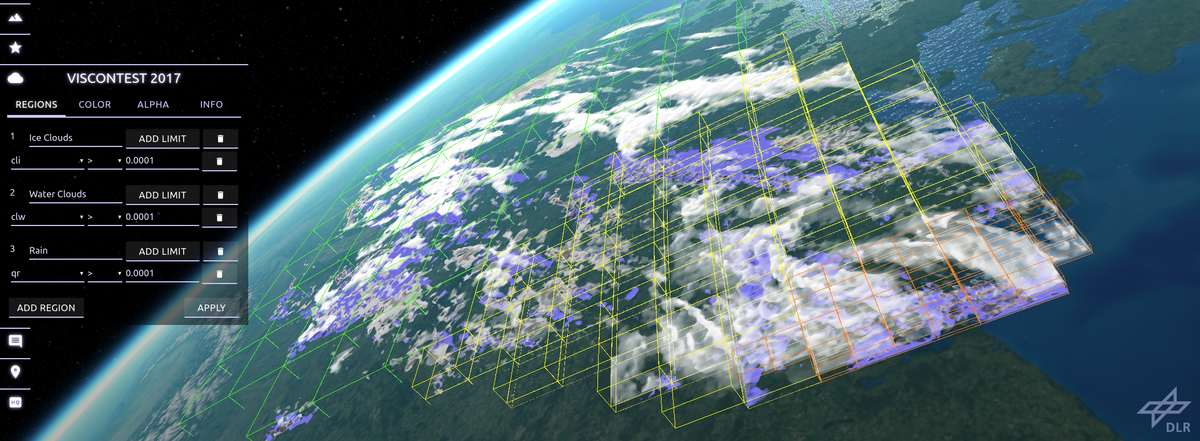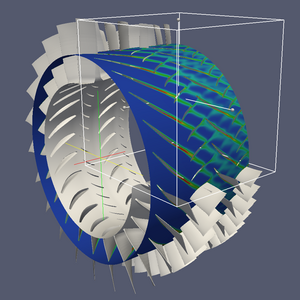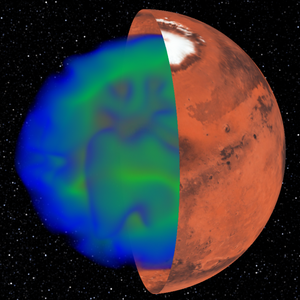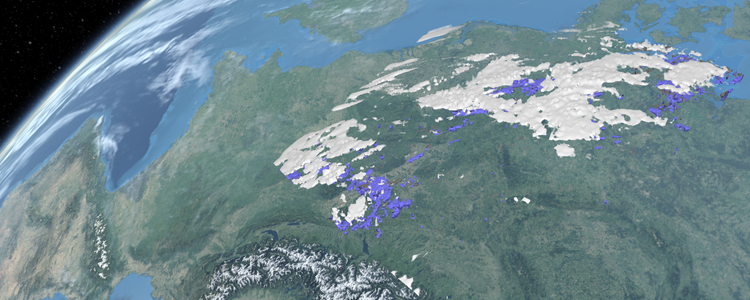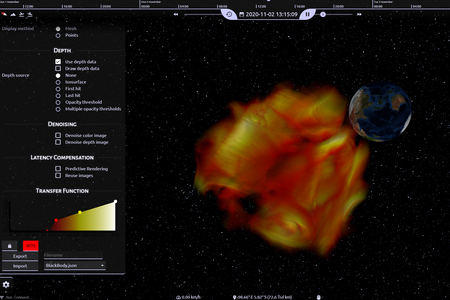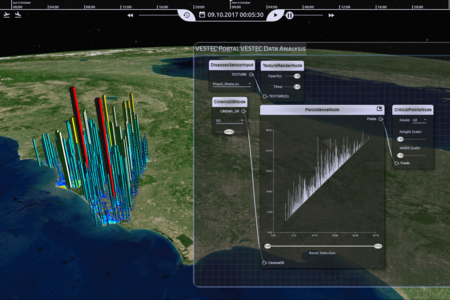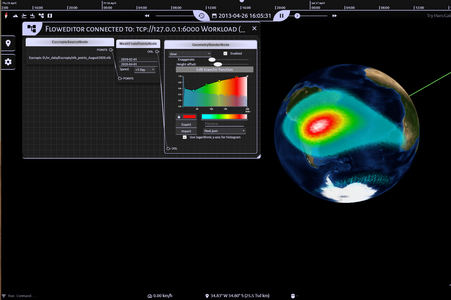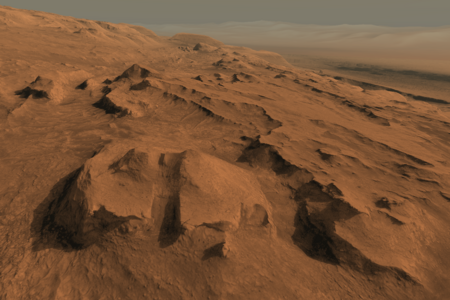View-dependent mesh resolution (Octree) for interactive exploration of a weather simulation dataset (IEEE Visualization Contest 2017)
AG High-Performance Visualization
The working group investigates the mathematical foundation of scientific visualization. It aims at methods for parallel post-processing of very large-scale datasets. Such data occurs in plenty of scientific applications. It is created by simulations on high-performance supercomputers (e.g. to support climate research or analysis of flow fields at airfoils). It can also be the outcome of measurements as it occurs in Earth observation missions. To get any insight into the scientific results, first of all, a huge amount of raw data has to be processed to extract meaningful features. Those features can eventually be explored in interactive working environments. To enable real-time exploration at the end of the processing pipeline, again highly parallel and efficient methods are required. They have to be optimized for the execution on distributed computing clusters and high-end graphics cards.
Applications
Applications in scientific visualization are manifold. A classical domain is Aerodynamics which uses numerical approaches to solve fluid dynamics problems. The most popular solution based on Navier-Stokes Equations (NSE) which helps to compute flow fields around airplanes or flows within combustion engines. Also measurements, like PIV methods (Particle Image Velocimetry), yield very precise and high-resolution results with respect to space and time.
Another source of large-scale measured datasets is Earth observation. Not only terrain data are retrieved but also 3D atmospheric data are collected which can be used e.g. for climate research. Radar sensors can also provide data from within the crust of planets. Mantel convections, however, require again highly complexe simulations. One of the interactive exploration tools offering insight into those multi-variate and time-dependent datasets is CosmoScout VR.
Independent from the before mentioned disciplins are medical data processing and molecular dynamics. For quantitative analyses, scientific as well as big data is explored with help of Information Visualization. Especially for the investigation of unknown data, explorative methods come into play. Those are essential parts of Visual Analytics and of immersive environments exploiting VR-technologies (Virtual Reality).
Here, students can find thesis and internship offers in all announced topics. Their supervision is carried out in cooperation with the DLR Institute for Software Technology, Braunschweig. If listed offers do not fit or own interests are not addressed at all, it is possible to get in touch with the work group to ask for individual topics. Besides open student jobs, also open positions as PhD student and scientific researcher are listed here.
Besides regular opportunities at University Bremen or German Aerospace Center (DLR), other interesting offers related to the addressed topics are listed here as well. These can be links to summer schools or further scientific positions (e.g. training positions at the European Space Agency, ESA).
Internal Advertisements
Current opportunities for final theses are offered here. If no matching topics are listed, just get in touch with the team!
- Student Position: Software Development for Multispectral Data Processing for Mars
External Advertisements
- Research Position: Research in Model Checking and Systems Engineering (DLR 67723)
Simon Schneegans, Jonas Gilg, Volker Ahlers, Andreas Gerndt
Real-Time Rendering of Eclipses without Incorporation of Atmospheric Effects
Pacific Graphics, Hybrid Event, Kyoto, Japan, October 5-8, Computer Graphics Forum, Volume 41, Issue 7, EG / Wiley, 2022
Simon Schneegans, Moritz Zeumer, Jonas, Gilg, Andreas Gerndt
CosmoScout VR – A Modular 3D Solar System Based on SPICE
Proceedings, IEEE Aerospace Conference, Hybride Event, Big Sky, MT, March 5-12, 2022
Tobias Franz, Christoph Seidl, Philipp M. Fischer, Andreas Gerndt
Utilizing Multi-level Concepts for Multi-phase Modeling
Software and Systems Modeling Journal (SoSym), Vol. 21, Jan. 22, 2022
Sascha Müller, Adeline Jordon, Andreas Gerndt, Thomas Noll
A Modular Approach to Non-deterministic Dynamic Fault Trees
40th International Conference on Computer Safety, Reliability and Security (SAFECOMP 2021), Virtual (York, UK), LNCS, Vol. 12852, Springer, Cham, Sep. 8-10, 2021
Andreas Lund, Zain Alabedin Haj Hammadeh, Patrick Kenny, Vishav Vishav, Andrii Kovalov, Hannes Watolla, Andreas Gerndt, Daniel Lüdtke.
ScOSA System Software: The Reliable and Scalable Middleware for a Heterogeneous and Distributed On-board Computer Architecture.
CEAS Space Journal, Springer, 2021.
Ayush Mani Nepal, Arnau Prat i Sala, Kilian Johann Höflinger, Andreas Gerndt, Daniel Lüdtke.
Modeling and Simulation of a Spacecraft Payload Hardware Using Machine Learning Techniques.
Accelerating Space Commerce, Exploration, and New Discovery Conference, ASCEND 2020, Virtual Event, Nov. 16-18, 2020, American Institute of Aeronautics and Astronautics (AIAA), 2020.
Sascha Müller, Liana Mikaelyan, Andreas Gerndt, Thomas Noll.
Synthesizing and Optimizing FDIR Recovery Strategies from Fault Trees.
Science of Computer Programming, 196, pp. 102478, Elsevier BV, 2020.
Anna Bahnmüller, Syed Muhammad Azeem, Georgia Albuquerque, Andreas Gerndt.
Evaluation of Interaction Techniques for Early Phase Satellite Design in Immersive AR.
IEEE Aerospace Conference, Yellowstone Conference Center, Big Sky, Montana, March 8-13, 2020, IEEE, 2020.
Prof. Dr. Andreas Gerndt
University of Bremen
Center for Industrial Mathematics (ZeTeM) | Bibliothekstraße 5 | MZH | 28359 Bremen | Germany
Andreas Gerndt @ Uni-Bremen
German Aerospace Center (DLR)
Institute of Software Technology | Software for Space Systems and Interactive Visualization | Lilienthalplatz 7 | 38108 Braunschweig | Germany
Deputy Director of Institute | Head of Department
Telephone +49 531 295-2782 | Telefax +49 531 295-2767 | Andreas Gerndt @ DLR

